ALSACAT-1944-11-27-STRASBOURG-1
According to Harold T. Wilkins, on November 27, 1944, Lt. Henry Giblin, of Santa Rosa, California, pilot, and Lt. Walter Cleary, of Worcester, Massachusetts, radar observer, were flying at 1,000 feet in their British-built night fighter plane Bristol Beaufighter of the 415th NFS - night fighter squadron of the U.S. Army - when they saw a huge red light, 1,000 feet above them, moving at 200 miles per hour.
As the observation was made during an early evening of winter, the men decided that perhaps they had eaten something in the mess that did no good to them, and they were in no hurry to report their experience.
According to Jo Chamberlin, they were flying "in the Alsace-Lorraine region, south of Mannheim am Rhein", and made their observation when they were nearing the German city of Speyer. The objects were at about 1,500 feet above their own plane, and described as a "huge fiery orange ball of burning fire" that rushed into the night sky at an estimated speed of 250 miles per hour.
US ground radar stations said when they were called there was no enemy plane in the area at that time.
For NICAP, this occurred between Strasbourg and Manheim, the object was a blurred round ball of light twice the size of the full moon and of yellow, white, red colors, not of a single color.
Giblin and Cleary had decided to say nothing to the Intelligence, afraid of being ridiculed by their hierarchy. The trace of the incident does not appear in an official report, but initially in the American press on January 2, 1945.
I show in this file, besides that it is not obvious that the observation took place in Alsace, that the explanation is probably a V-2 rocket launch.
| Date: | December 1944 |
|---|---|
| Time: | Night? |
| Duration: | ? |
| First known report date: | 1945. |
| Reporting delay: | Hours, days? |
| Department: | Haut-Rhin |
|---|---|
| City: | Strasbourg |
| Place: | In plane in flight. |
| Latitude: | 48.581 |
| Longitude: | 7.747 |
| Uncertainty radius: | 20 km |
| Number of alleged witnesses: | 2 |
|---|---|
| Number of known witnesses: | 1 or 2 |
| Number of named witnesses: | 2 |
| Witness(es) ages: | Adults. |
| Witness(es) types: | Military pilot and on-board radar operator. |
| Reporting channel: | The Press. |
|---|---|
| Type of location: | In plane in flight. |
| Visibility conditions: | ?t |
| UFO observed: | Yes |
| UFO arrival observed: | ? |
| UFO departure observed: | ? |
| Entities: | No |
| Photographs: | No. |
| Sketch(s) by witness(es): | No. |
| Sketch(es) approved by witness(es): | No. |
| Witness(es) feelings: | ? |
| Witnesses interpretation: | ? |
| Hynek: | NL |
|---|---|
| ALSACAT: | Probable V-2 rocket launch. |
[Ref. dhd1:] NEWSPAPER "THE DECATUR HERALD":
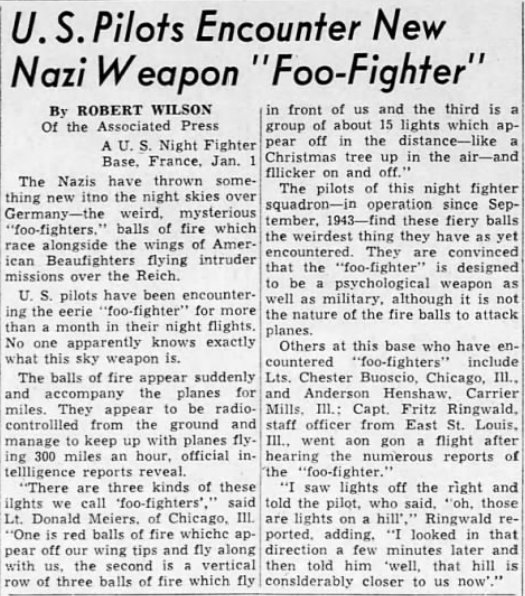
|
By ROBERT WILSON
Of the Associated Press
A U.S. Night Fighter Base. France. Jan. 1
The Nazis have thrown somethig new into the night skies over Germany - the weird, mysterious "foo-fighters," balls of fire which race alongside the wings of American Beaufighters flying intruder missions over the Reich.
U.S. pilots have been encountering the eerie "foo-fighters" for more than a month in their night flights. No one apparently knows exactly what this sky weapon is.
The balls of fire appear suddenly and accompany the planes for miles. They appear to be radio-controlled from the ground and manage to keep up with planes flying 300 miles an hour, official intelligence reports reveal.
"There are three kinds of these lights we call 'foo-fighters'", said Lt. Donald Meiers, of Chicago, Ill. "On is red balls of fire which appear off our wing tips and fly along with us, the second is a vertical row of three balls of fire which fly in front of us and the third is a group of about 15 lights which appear off in the distance - like a Christmas tree up in the air - and flicker on and off."
The pilots of this night fighter squadron - in operation since Spetember, 1943 - find these fiery balls the weirdest thing they haveas yet encountered. They are convinced that the "foo-fighters" is designed to be a psychological weapon as well as military, although it is not the nature of the fire balls to attack planes.
Others at this base who have encountered "foo-fighters" include Lts. Chester Buoscio, Chicago, Ill., and Anderson Henshaw, Carrier Mills, Ill; Capt. Fritz Ringwald, staff officer from East St. Louis, Ill., went aon gon [sic, along on] a flight after hearing the the numerous reports of the "foo-fighters."
"I saw lights off the right and told the pilot, who said, 'oh, those are lights on a hill'," Ringwald reported, adding, "I looked in that direction a few minutes later and then told him 'well that hill is considerably closer to us now'."
[Ref. cte1:] NEWSPAPER "THE CHICAGO TRIBUNE":
Lt. Wallace Gould of Silver Creek, N.Y., said the lights followed his wing tips for a while and then, in a few seconds, zoomed 20,000 feet into the air out of sight.
Lt. Edward Schlater [sic, Schlueter] of Oshkosh, Wis., said he had seen the "Foo-Fighter" on two occasions and it "looked like shooting stars."
Pilots agreed that the balls of fire were more numerous over large German cities. None saw any structure on the fire balls.
Other pilots at this base who have encountered "Foo-Fighters" include Lieutenants Henry Bockstige, Evansville, Ind. and Chester Bouscio, 9752 Avenue M, Chicago; Radio Navigators Lieutenants Anderson Henshaw, Carrier Mills, Ill., and Richard Early, Kalamazoo, Mich.
Many Encounter Flares
Among other flyers who have reported encountering the flares were Lieutenants Garland Moore, Charleston, W. Va., Hubert Moore, Greenwood, Miss., Austin Tetry, York, Pa., Warren Rodich, New Orleans, La., Frank Sardon, El Segundo, Cal, and Flight Officers Murphy Painter, Gonzales, La., Razomond Meyer, Middletown, Conn., and Lt. Richard Urich, Trenton, N.J.
Others included Capt. Charles Horne, Doerun, Ga.; Lieutenants Richard Wanda, Cleveland, O.; Charles Tournier, Lewiston, Me.; Henry Giblin, Santa Rosa, Cal.; Owen Davis, St. Petersburg, Fla.; Charles Ingraham, Waynesburg, Pa.; George Schroch, Willoughby, Ol., and William Flanagan, Meridien, Miss.
[Ref. chn1:] JO CHAMBERLIN:
But a few nights later, Lt. Henry Giblin, of Santa Rosa, California, pilot, and Lt. Walter Cleary, of Worcester, Massachusetts, radar-observer, were flying at 1,000 feet altitude when they saw a huge red light 1,000 feet above them, moving at 200 miles per hour. As the observation was made on an early winter evening, the men decided that perhaps they had eaten something at chow that didn't agree with them and did not rush to report their experience.
[Ref. hws1:] HAROLD T. WILKINS:
On November 27, 1944, another act in the foo fighter drama was staged. Lieutenant Henry Giblin, native of Santa Rosa, Calif., was flying a U.S. night fighter in the Alsace Lorraine region, south of Mannheim-am-Rhein. He had with him Lieutenant Walter Cleary of Worcester, Mass., as radar-observer. As they were approaching the German town of Speyer on the Rhine south of Mannheim, they got a shock. Some 1,500 feet above their own plane a “hell of a huge fierce, fiery orange light” shot across the night sky at an estimated speed of 250 miles per hour. Again U.S. ground radar stations reported when called: “No enemy machines in the vicinity. Only your own plane in the sky over there.”
Giblin and Cleary decided to say nothing to intelligence, fearing ridicule from higher quarters. It is not wise for a war-time flyer to take such a risk. Let someone else do the reporting!
[Ref. kap1:] KENNETH ARNORLD AND RAY PALMER:
On November 27, 1944, another act in the foo fighter drama was staged. Lieutenant Henry Giblin, native of Santa Rosa, California, was flying a U.S. night fighter in the Alsace-Lorraine region, south of Mannheim-am-Rhein. He had with him Lieutenant Walter Clearly of Worchester, Mass., as radar-observer. As they were approaching the German town of Speyer on the Rhine south of Mannheim, they got a shock. Some 1,500 feet above their own plane a "hell of a huge fierce fiery orange light" shot across the night sky at an estimated speed of 250 miles per hour.
Again U.S. ground radar stations reported when called: "No enemy machines in the vicinity. Only your own plane in the sky over there."
Giblin and Cleary decided to say nothing to intelligence, fearing ridicule from higher quarters. It is not wise for a war-time flyer to take such a risk - let someone else do the reporting!
[Ref. jve1:] JACQUES VALLEE:
|
|
Lieutenants Henry Giblin and Walter Cleary saw a huge fiery object above their plane on November 27, 1944 at Speyer, Germany.
[Ref. gle1:] GORDON LORE AND HARROLD H. DENEAULT:
The authors say that during the early hours of a November evening in 1944, Lieu-tenant Henry Giblin of Santa Rosa, California, and his radar observer, Lieutenant Walter Cleary of Worcester, Massachusetts, were flying at 1,000 feet when they spotted a "huge red light" about 1,000 feet above them. They clocked the object at 200 miles an hour.
[Ref. vgs1:] VINCENT H. GADDIS:
The author says that four nights after November 23, 1944, Lieutenant Henry Giblin, pilot, and Lieutenant Walter Cleary, radar observer, were flying at a thousand feet of altitude in the Alsace-Lorraine region, south of Mannheim-am-Rhein, when they saw a large red light about 1.000 feet above them, flying at a speed of 250 mph. Nothing was detected by the ground radar.
[Ref. jcf1:] JEROME CLARK AND LUCIUS FARISH:
[...]
During WW II, when a series of incomprehensible events suddenly erupted over battle zones from North Africa to Guadalcanal to the Rhineland, hundreds of fliers and infantrymen on both sides of the conflict had occasion to look into the skies at a mystery that has never been explained. Whatever the cause, these weird aerial apparitions, which came to be known as "foo fighters", were enough to make witnesses forget momentarily the life and death concerns of men in combat.
[...]
Over the Rhine Valley early one November evening in 1944, Lt. Henry Giblin and his radar observer, Lt. Walter Cleary, sighted a "huge red light" 1,000 feet above them (they were flying at 1,000 feet). The object was moving at about 200 miles per hour. About the same time two other airmen encountered a "glowing red object" which shot up vertically, turned over, and plunged into a steep dive. The witnesses were sure the thing was under intelligent control.
About eight or 10 bright orange lights startled the crew of an American aircraft connected with the 415th Night Fighter Squadron as the plane cruised the Rhine River area north of Strasbourg one November night. Curiously, the lights, which were moving across the sky at tremendous speed, did not show up on either ground or aircraft radar. The pilot, Lt. Ed Schlueter, banked into them expecting a dogfight, but much to his astonishment the objects completely disappeared, only to reappear seconds later. After five minutes the lights were gone.
[...other cases...]
Foo fighters continued to plague the 415th all through January 1945. Usually the lights, colored orange, red, or white, would tail the aircraft for a few moments before streaking away. The ghostly objects never showed up on radar, but the veteran crews discounted theories that the glowing globes were reflections, St. Elmo's fire, or flares, all of which they had observed many and would have easily recognized. One pilot even insisted that he had felt prop wash as the foos zipped passed him.
[Ref. rvo1:] RENATO VESCO AND DAVID HATCHER CHILDRESS:
On November 27, 1944, two pilots, Henry Giblin and Walter Cleary, encountered an enormous, burning orange light in the vicinity of Speyer. It was flying at about 250 mph about 1500 feet above their fighter plane. The radar station in the sector again radioed back the equivalent of "Nuts!" when the pilots queried the presence of this threat.
The plane's own radar almost immediately began to malfunction, and they had to return to base. A detailed report - the first acknowledgment in official form - confirmed the existence of the inexplicable lights, and the two men who reported them became the butt of many jokes.
[Ref. ldl1:] UFOLOGY MAGAZINE "LUMIERES DANS LA NUIT":
The magazine indicates that on November 27, 1944, a crew of the 415th NFS made an astonishing observation in Speyer, Germany, 4 days after Schülter, Meiers and Ringwald's sighting. Witnesses were lieutenants Henry Giblin, pilot, and Walter Cleary, onboard radar man. To the south of Mannheim, they saw at night a huge sphere emitting an orange light, which seemed to them to move 500 meters higher than their plane, and at a speed of at least 400 km / h. They alerted the ground radar; which had no other echo than that of the plane.
[Ref. wpl1:] "THE WORLD OF THE PARANORMAL":
This book says that pilots Henry Giblin and Walter Cleary reported that on the night of September 27, 1944, they had been harassed in the vicinity of Speyer by an "enormous burning light", about 1.000 feet above them, flying at a speed of 250 mph.
[Ref. gpd1:] GEORGE PICCARD:
And let us not forget the foo-fighters, those mysterious luminescent spheres wibtessed by Allied pilots. In November of 1944, the Allied pilots Henry Giblin and Walter Cleary encountered a large burning orange light near Speyer. It was flying at a speed of 250 mph and it was within a quarter mile above them. The plane's radar system began to malfunction. The pilots flew back to base to file an official report.
[Ref. mbd1:] MICHEL BOUGARD:
The author indicates that on November 27, 1944, Lieutenants Henry Giblin and Walter Cleary were on a mission over the region of Mannheim when, above Speyer they saw a huge orange ball of light that moved at a speed of 400 km / h barely 500 meters above their plane. The radars were silent.
[Ref. pg1:] MYSELF, PREVIOUSLY:
The primary source seems to be the famous article of 1945 by Jo Chamberlin [cha] on "foo fighters", which says:
"But a few nights later [end of November, 1944], Lt. Henry Giblin, of Santa Rosa, California, pilot, and Lt. Walter Cleary, of Worcester, Massachusetts, radar-observer, were flying at 1,000 feet altitude when they saw a huge red light 1,000 feet above them, moving at 200 miles per hour. As the observation was made on an early winter evening, the men decided that perhaps they had eaten something at chow that didn't agree with them and did not rush to report their experience."
This version of the story had been republished many times since, such as in "Fortean Studies" N.7.
During World War II, Renato Vesco was a very young aircraft engineer, and after the war he wrote articles and books about secret German weapons [ves]. According to a text that appears on several websites, he indicates:
"On November 27, 1944, a B-27 of the United States Air Force [sic], returning from a raid on Speyer, West Germany, encountered a huge, orange colored light moving upward at an estimated speed of 500 mph. When the pilots reported, sector radar had reported negatively, because nothing had registered on the screen."
The same story is seemingly told in the French ufology magazine "Phenomena"[phe], the bulletin of the defunct group "SOS-OVNIS" with additional details that it was 08:26, a huge orange sphere, at an altitude of 450 meters and the crew is described as a "fighter crew" rather than a bomber's crew.
In Dominique Weinstein's catalogue [wei], the case appears with the same date and location, as that of a huge orange sphere seen at midnight by a USAAF P-70 fighter of the 415th night fighters squadron.
W. A. Harbinson [har] provides other details, indicating that the witnesses were pilots Henry Giblin and Walter Cleary, who stated that on the night of November 27, 1944, they had been harassed in the vicinity of Speyer by "an enormous burning light" that was flying above their aircraft at about 250 miles per hour.
An anonymous website indicates that on November 27, 1944 in Speyer, Germany, "a large red fireball flew parallel to the fighter plane of Lts. Henry Giblin and Walter Cleary. They tried evasive maneuvers, but the craft was able to mirror their movements. After a time, the craft accelerated off above the maximum altitude of the fighter."
A British website says that on November 27, 1944 while in the vicinity of Speyer, at an altitude of 1,000 feet, Lt. H. Giblin and Observer W. Cleary were tailed by an enormous burning light which flew above the plane at a speed of more than 200 mph.
The plane could not have been a Martin B-27 since this aircraft was only a project and was abandoned in 1940, no prototype being built. This puts doubt on the version of the sighting by Renato Vesco, who also incorrectly refers to the United States Air Force (USAF) that was actually formed in 1947 while the US air forces were names US Army Air Force (USAAF) then. While there are many better documented foo fighters cases, this one might be invented, or more likely, a mix-up of other cases. Renato Vesco has unwillingly become a hero for "nazi saucers" cultists, and is claimed to be an "expert" who has worked on such projects, but the truth is he was too young at the time to hold any such position, he did not work for the Germans, and he makes a blatant mistake here by telling that the plane was a Martin B-27.
On the contrary, Jo Chamberlin's version is very probably totally accurate. Chamberlin lists other foo fighter sightings by the 415th Night fighter Squadron, and I found out that they are generally supported by official records.
Other sources mention the P-70 Havoc nightfighter, a somehow inefficient converted bomber and trainer, that had a battery of forward-firing guns, and a single hand-held machine gun in the dorsal position that was later replaced by a two-gun Martin turret. But the P-70 was very ineffective, and had been replaced by British made Bristol Beaufighters at the 415th NFS early in 1944. The plane could thus have been a Beaufighter. The Beaufighters also proved rather ineffective, and by the summer of 1944, there were being replaced by the much more effective Northrop P-61 Black Widow.
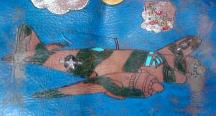
Jacket badge of the US 415th night fighters squadron, showing the British Bristol Beaufighter plane they used. |
So the correct event very likely goes like this:
Towards the end of November, 1944, Lt. Henry Giblin, of Santa Rosa, California, pilot, and Lt. Walter Cleary, of Worcester, Massachusetts, radar-observer were flying a P-70 on training mission or a Beaufighter or a P-61 in combat mission at 1,000 feet altitude when they saw a huge red light 1,000 feet above them, moving at 200 miles per hour. The men thought they had visions or did not dare to look like fools and reported the sighting only after other pilots of that same unit reported several other foo fighters sightings, and this is why it does not appear on the 415th war diaries.
What the huge red light above them could have been is impossible to say as the case stands now due to lack of data. It does obviously did not fly faster than a plane can, no exotic maneuver is reported, no pursuit, no dogfight, no exotic shape.
The '*' indicates sources that I own or checked, the '?' indicates sources that I have not been able to read yet.
[Ref. nip1:] "THE NICAP WEBSITE":
Bright fuzzy round ball, twice the size of full moon; yellow, white, red tint that was not solid color; no radar return. (Page 118-119 Ref.1)
The indicated reference corresponds to "Strange Company (2007), Keith Chester".
[Ref. jrn1:] JEAN ROBIN:
Jean Robin says that "the pilots" Henry Giblin and Walter Cleary had reported that on the night of "September 27, 1944", they were followed by a "huge fireball" that flew over their aircraft at a speed of about 400 km / h.
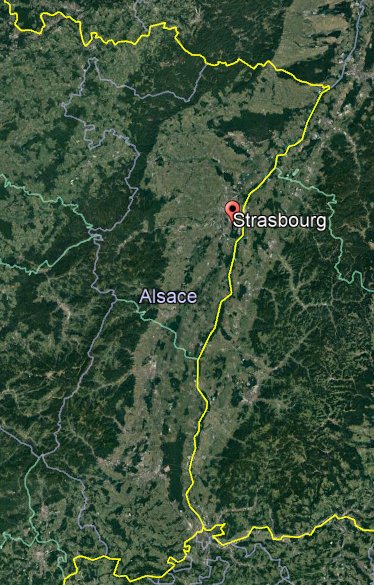
|

|
Above: jacket badge of the US 415th Night Fighters Squadron, showing the British Bristol Beaufighter plane they used at that time.
Crews of the 415th Night Fighter Squadron of the U.S. Army Air Force reported their nocturnal observations of what they called "Foo Fighters" above the Rhine valley then occupied by the Germans, between November 1944 and April 1945, as their base was in Dijon and Ochey in France.
Their reports apparently ceased when the Germans lost Alsace.
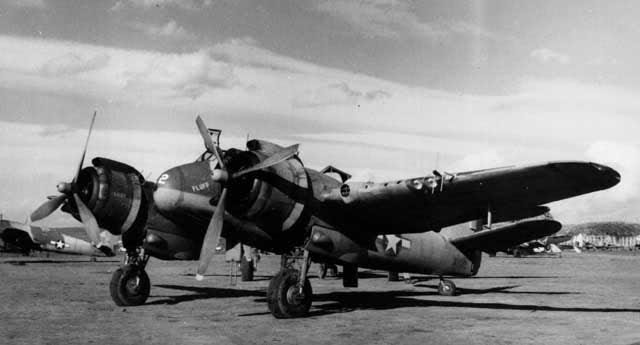
|
Above: a 415th NFS Bristol Beaufighter.
Let's see this particular case. First, the question of geographical location arises. This catalog documents observations in Alsace. But the location of this sighting is unclear.
Chamberlin gives no location, Wilkins says "in the Alsace-Lorraine region, south of Mannheim-am-Rhein", Vesco and Piccard say "in the neighborhood of Speyer" which is in Germany, and NICAP says "Between Strasbourg and Manheim, Germany."
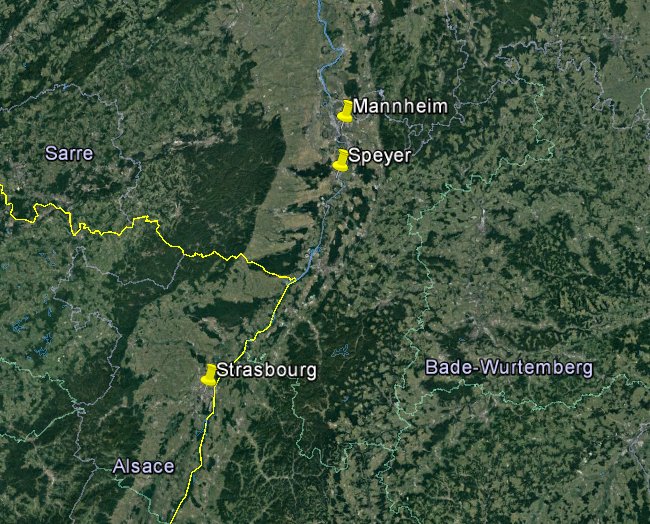
|
Chronologically, the case would be the second known case of "Foo-Fighters" in the French Rhine valley, 4 days after the November 23, 1944, sighting.
I will not go over the various possibilities of explanation that can be or have been considered - meteors, Messerschmitt Komet, St Elmo fire, extraterrestrial craft - because one of them seems to me to be the best one for this observation.
It happens that on November 27, 1944, two Nazi V-2 rockets caused about 150 deaths in Antwerp (Anvers) in the north of Belgium. At least one other fell on Lincé in the east of Belgium, supposed to destroy a lock in order to flood Holland, or destroy facilities of the Allied General Staff in Bierset. There are no precise data on their launch site, but the "Bonn and Koln (Cologne) regions" are mentioned. These towns are between 150 and 200 kilometers from the sighting location - given the uncertainty about the latter.
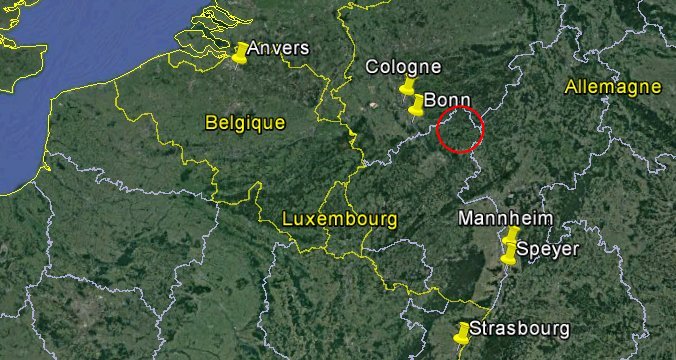
|
I actually found V-2 launch pads in the Westerwald at Hillscheid, Helferskirchen, Gehlert, among other places. These places are only 120 km north-northeast of Mannheim, so a V-2 launch would have been perfectly visible from the witnesses' plane. These launch pads are located within the red circle on the above map.
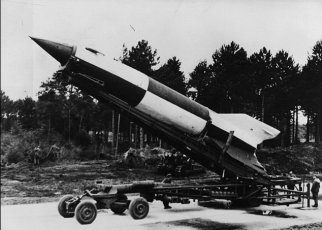
|
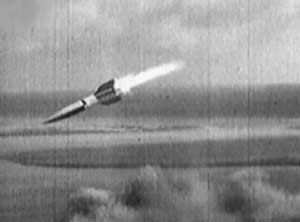
|
Probable V-2 rocket launch.
* = Source is available to me.
? = Source I am told about but could not get so far. Help needed.
| Main author: | Patrick Gross |
|---|---|
| Contributors: | None |
| Reviewers: | None |
| Editor: | Patrick Gross |
| Version: | Create/changed by: | Date: | Description: |
|---|---|---|---|
| 0.1 | Patrick Gross | March 28, 2017 | Creation, [cte1], [chn1], [hws1], [gle1], [vgs1], [rvo1], [gpd1], [rvo1], [nip1], [jrn1]. |
| 1.0 | Patrick Gross | March 28, 2017 | First published. |
| 1.1 | Patrick Gross | July 25, 2022 | Additions [kap1], [jcf1]. |
| 1.2 | Patrick Gross | February 4, 2023 | Addition [dhd1]. |